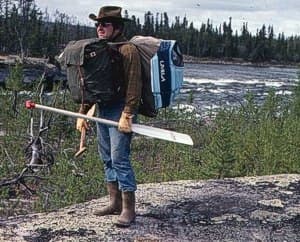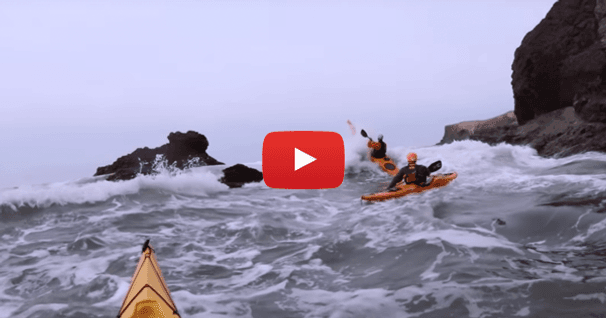9 Costly Canoeing Mistakes

For nearly 40 years, I canoed one or more Canadian or Alaskan rivers each summer. In the late 1970's, I began guiding canoe trips for my local school district and the Science Museum of Minnesota. Some were easy Boundary Waters/Quetico affairs, others were adventurous runs to Hudson Bay and the Arctic Ocean. Injuries? Some minor cuts and sprains and two mild cases of hypothermia, that's all. Canoes damaged beyond repair or lost in rapids? None. Mistakes? Plenty! Here are some costly mistakes you won't want to make.
CARRYING A PACK ON YOUR CHEST
"Double-packing" (carrying two packs at once) is the rule on wilderness canoe trips. Some people carry one pack on their back and a second on their chest-supposedly to balance the load. But a front pack obscures your view of the trail and encourages falls. And sprains! I double stack packs on my back and tote 'em with a tumpline. The rule on my canoe trips is "no packs on your chest". Ever!

UNRELIABLE BACK-FERRY
Whitewater experts tend to dismiss the back-ferry as a knee-jerk approach to running rapids. They prefer the more powerful forward-ferry. But turning a loaded wilderness canoe around in a powerful rapid requires space, time and teamwork. The following example illustrates how a back-ferry can save the day.
My wife, Susie and I were running a long rapid on Manitoba's Seal River. Suddenly, Susie screams: "Falls!" We were in the tongue and two canoe lengths from the drop. There was a Volkswagen-sized boulder six feet away on my left.
"Back!" I screamed. Momentarily, the canoe stopped in its tracks. I pried the stern around and we ferried to the rock. One more yard (literally!) and we'd have gone over the falls!
Canoeing a wild river without a polished back-ferry is the most serious mistake you can make!
AN OVER-AMBITIOUS SCHEDULE
Fifteen miles a day is a reasonable average on most northern rivers. Add one "down day" in five for bad weather and the unexpected, and you should be where you need to be when you need to be. Still, there are no guarantees. It can storm for a week; high or low water levels may require grueling portages that eat up your time; a strong wind may be always in your face, etc. Most disasters result from "running out of time and taking chances". My advice? Slow down. Way down! Ten miles a day is a pleasant plan. Your crew will appreciate a few extra layover days.
POORLY DEFINED RESPONSIBILITIES
Well into their 7,000 mile canoe trip to the Bering Sea, Verlen Kruger discovered that part of the canoe's spray cover had been left behind on a portage. He thought that his partner, Clint Waddell had portaged it. Clint figured Verlen had it.
As this case illustrates, even experienced paddlers need a plan. For example, one canoe team may always carry the tundra tarp, wanigan box and saw. Another might always bring the cook-set, axe, first-aid kit and stove. Items are never switched around. In camp, everyone takes their turn at these chores: cook's helper, tarp rigger, fire builder, water-hauler and gopher. On my trips, responsibilities generally last three days-enough time to develop expertise that will "beat the storm".
INAPPROPRIATE ATTIRE
In their classic text, The Complete Wilderness Paddler, Rugge and Davidson poke fun at a friend who shows up with a cheap plastic rain-suit. Requiring the man to bring a more reliable one would have been a better plan. We're all family on a canoe trip, and one miserable paddler is enough to spoil the stew. That's why everyone on my trips gets a detailed equipment list. Reasonable substitutions are allowed.
Proper footwear is critical, as this case illustrates:
Some years ago, I led a canoe trip down Manitoba's Caribou River. Everyone was told to bring knee-high rubber boots. One woman abandoned the plan and wore Gore-Tex socks inside sneakers. By day three she had stopped smiling. The Gore-tex socks were torn and her feet were freezing. Fortunately, my wife, Susie, had brought a pair of lightweight Tingley® rubber boots to wear in camp. Reluctantly, she gave the Tingley's to the frigid-footed woman who completed the trip in comfort. Still, Susie was mad because she no longer had a change of shoes for camp. Should we have allowed the woman to suffer? Perhaps. But all of us would have shared her misery.
Moral? Stick by your equipment list and have a full field inspection before the wheels roll north!
POSITIVE MENTAL ATTITUDE
If your canoeing has been limited to lake country routes like those in the Boundary Waters and Quetico, you may not realize how nasty things can get on a Canadian river. For example, It has been calculated that 95 percent of all the protoplasm in the far north is in the bodies of black flies and mosquitoes. Frankly, there are times when I've thought they were all on me! When bug dope, head nets, bug jackets and netted tarps are not enough, there is attitude--positive mental attitude. Without it, the critters will eat you alive! Friends who cannot "adjust to the elements" are best left out of your tripping plans. Ditto, those who don't understand why every day cannot begin at eight and end at five. You must be willing to make up lost time on those rare occasions when the wind is at your back.
Again-positive mental attitude!

FOLLOWING TOO CLOSE OR TOO FAR APART IN RAPIDS
A traffic jam can have serious consequences in a complex rapid. For this reason, whitewater paddlers like to leave a fair amount of space between their boat and the one behind. On the other hand, if teams are too spread out, they can't take advantage of the leader's "route decisions". What to do?
My experience suggests that following too close is by far the better plan, especially, if there are novices who can't read water and who don't have a reliable back-ferry. Five canoe lengths is adequate to prevent crashes, yet close enough for followers to observe-and duplicate-maneuvers that are modeled by the leader.
WEARING AN UNZIPPED LIFE JACKET
Hot and sweating, you loosen the straps of your life jacket and open the zipper to let in cool air. Seconds later, a downed tree looms into view. "Back!" You holler. But it's too late. You capsize and are swept into the branches of the strainer. The "wings" of your unsecured PFD wag in the water and an arm hole catches a branch. You stop with a jerk and are momentarily held under water. Thank God you're able to get free! Next time you go canoeing you'll keep your life jacket zipped up tight!
On the heels of this comes advice to constantly monitor your crew for life jackets. Paddlers sometimes forget to "buckle up" after a rest stop or portage. The wise trip leader uses sensitivity and comedy to call attention to a dangerous over-sight-"Say, John I saw bear scat on the last portage. Did that fat boy steal your life jacket."
INEXPERIENCE AT LINING
Shoreline vegetation thins out dramatically with each mile you go north. On tundra routes, you can literally run along the barren rocks which line the river banks. The rule up north is "don't portage any rapid you can line!"
Canoeing texts make lining rapids sound easy. It isn't! Controlling the path of a heavily loaded canoe in the powerful side-wash of a rock-studded passage requires practice, agility and an understanding of "current problems".
Every wilderness paddler has horror stories about canoes that were damaged or destroyed while lining. Practice lining your (loaded!) canoe around some tough rapids before you paddle a wild river.
Cliff Jacobson is a professional canoe guide and outfitter for the Science Museum of Minnesota, a wilderness canoeing consultant, and the author of more than a dozen top-selling books on camping and canoeing. www.cliffcanoe.com
Related Articles
Learn what you need to remember to grab every time you hit the water no matter if your paddling a canoe,…
When a situation occurs while paddling in a group, conditions don't stop. Learn some pointers on how to…
One of the great things about stand-up paddle boarding is that it can be a remarkably safe and…
Whenever you go paddling there's a certain amount of equipment that you have to think about before you…



